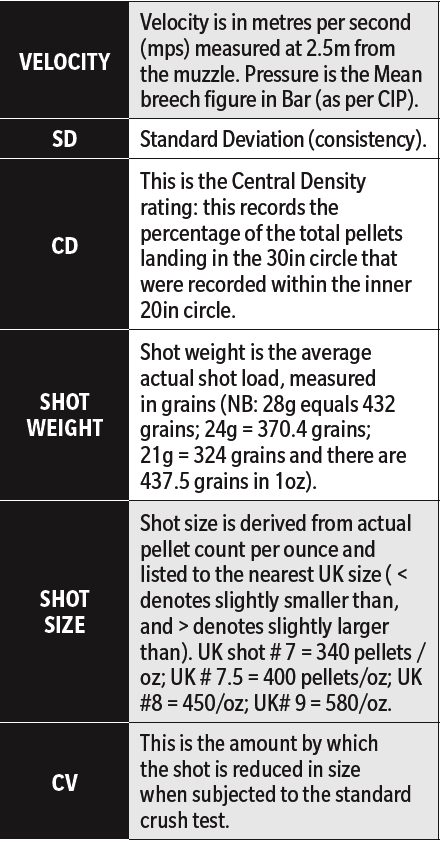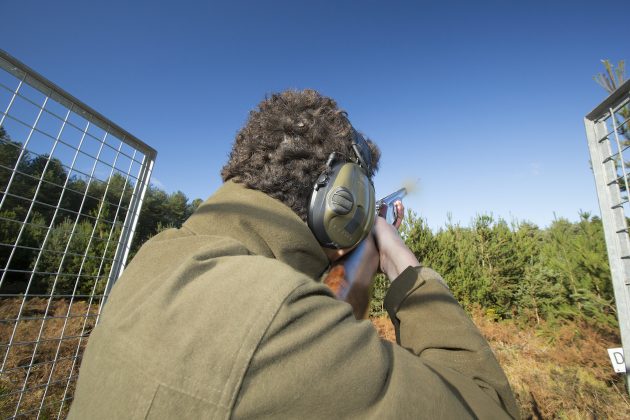Two budget clay cartridges from Gamebore, the Velocity+ and the Evo 21, go head-to-head and Richard Atkins is impressed
Budget clay cartridges on test: how did they perform?
Budget clay cartridges from Gamebore
We thought we’d investigate some budget clay cartridges from Gamebore. In today’s tough economic climate, there are more shooters seeking to trim their shooting expenditure. It’s a logical step to seek a less expensive cartridge – something all cartridge makers are aware of. Even brands whose cartridges had long targeted the top competition Shots almost exclusively have introduced budget options into their product range in more recent times.
Gamebore cartridges are well known and respected in clay and game shooting circles, with an array of highly rated ‘Gamebore Ambassadors’ using its products. These include multi-world sporting champion George Digweed MBE, Mark Winser and, on the game front, high-bird exponents such as Simon Ward and Dave Carrie. The exalted reputations of these shooters prove that Gamebore produces ammunition that meets the requirements of the country’s elite Shots. (Read more on best vests for clayshooting.)
It’s worth noting that, for a great many of us, the targets we choose to shoot on a typical weekend sporting round are unlikely to include many 50-yard-plus quartering-away looping battues or distant and fast-departing high-speed midi clays. A majority of sporting clay grounds I have visited set their targets to suit their regular customers, who have mostly come to enjoy themselves among friends. While they like to be challenged to a degree, they like to break comfortably above half of the targets they engage and preferably more. (Read more on how to deal with different clay targets.)
This works well, and the huge popularity of sporting clay grounds find this a good way to please customers and keep them coming back. We all know grounds that also have some testing targets which will be used for more serious competition days. The fact is that a majority of targets set at such clay grounds do not require the shooter to use the premium cartridges that a major competition most likely will.

Gamebore’s Evo is one of the budget loads on test
It is easy enough to include a box of premium ammunition in your bag, just in case there is a really tough stand; these will help on those more difficult targets. It’s also important to realise that there really is a difference in performance between the ‘premium’ and ‘budget’ cartridges within any maker’s range. It should be unnecessary to point this out but, if you read enough comments on shooting forums, it becomes clear some think that the main difference is a higher metal head on the case, which in their eyes allows the cartridge maker to ‘rip us off’. That, however, is not the case. Putting that aside, let’s see how these Gamebore budget options measure up.

The component make-up of the Evo cartridge
Components
Gamebore is an ISO 9001-accredited manufacturer, and so we are assured it operates to verified industry standards. It uses high-grade components and is the only UK cartridge company to have a shot tower with which it manufactures the bulk of the lead shot pellets it loads into Gamebore cartridges.
As with all other UK cartridge- loading companies, Gamebore does not manufacture cartridge cases or primers. It uses Baschieri & Pellagri (B&P) Gordon system cases for its premium clay and game loads and – up until the recent acquisition of B&P by Fiocchi – was the only UK supplier of cartridges loaded into this type of case. How the new B&P ownership might affect things going forward is unclear. For the remainder of its cartridge range, Gamebore uses Cheddite cartridge cases, mostly loaded with CX2000 primers, known for consistency and reliability.
Gamebore does manufacture some plastic wads, but the wad used in the Velocity+ reviewed is not one of these; it is the B&P 28g Z2 wad, which is popular among cartridge loaders worldwide. This wad has a four ‘kinked leg’ collapsible centre section with support discs. The shotcup is full length for 28g shot loads, ensuring no pellets rub against the barrel wall. The cup has moulded slits to provide four shotcup ‘petals’, and these are joined by light plastic ribs that ensure reliable loading without hang-ups on automatic loading machines. The Evo uses an 18mm-long Diana one-piece fibre wad, recognisable by the black laminate ends, which resist grease egress. A 4mm-thick overpowder nitro card wad is also used.
While Gamebore uses B&P F2 powders for some premium offerings, it is powders from the Vectan range in the Velocity+ and Evo cartridges reviewed here. A charge weight of just 22.5 grains of the highly regarded and economical Vectan AS single-base nitrocellulose powder powers the Velocity+ to a respectable 398mps: this is, in fact, about an 8% velocity increase over the Velocity+ as first reviewed in 2016.
The Evo carries a similar charge weight, 22 grains, of the fast-burning, fine granular grain Prima SV single-base powder. This is also efficient for low shot-load 12-bore cartridges as evidenced by the Evo achieving 416mps even with the fibre wad. That is a very high velocity indeed.

Gamebore’s Velocity+ gave an impressive performance
Shot loads
Gamebore is, of course, known for its signature premium lead shot called Diamond Shot. This is produced using high-antimony lead ingots processed in its tall shot tower, which is capable of producing extremely round shot. This is then graded up to five times to achieve a consistent shot size for shorter shot strings at long range and then polished using a special compound that gives a nickel-like shiny finish (but isn’t nickel).
Diamond Shot is expensive to make and it is no surprise that neither the Evo nor Velocity+ are loaded with it. However, the shot roundness indicates the shot is made using the long-drop tower. Sizing is quite good too and well within the tolerance one would expect from a budget load but not quite so consistent as Diamond shot. The shot is not high antimony (antimony being expensive). Shot hardness is therefore less than that of premium cartridges but similar to that of some other budget cartridges.
Shot load weights, in both types, proved accurate to the stated weights and shot size was precise too. My notes from 2016 show that whereas the Velocity+ here are spot on UK 7.5, the previous batch tested contained UK 6.5 (although marked 7.5). This is another reason I suggest keen shooters take a closer look at the ammunition they buy and, if possible, do pattern tests too.

The component parts of the Gamebore Velocity+ cartridge
Laboratory tests
Following our standard procedure, both cartridges were submitted to the Birmingham Proof Laboratory for pressure, velocity and momentum testing. Patterns were fired from the regular improved modified bored test barrel – with 2¾in chamber and standard-length forcing cones over a 40-yard distance.
Evo results
The laboratory reports provide some interesting ‘vital statistics’, not least the high velocity of 416mps achieved by the Evo, remarkable for a fibre wad cartridge. Very high velocities always come with some potential side effects, and these can be seen too. One is that fibre wads do not seal the propelling gases as well as a plastic wad, and this can lead to more variation in velocity spread. Here the standard deviation (SD) figure shows the effects. An SD of 13.7 does not sound a lot. What it actually means is that the velocity of the 10 test shots ranged from a high of 436mps to a low of 398mps – a spread of 38mps. This is 125fps.
An interesting aspect here is that some people feel a cartridge might be ‘slow’ if the average velocity is 100fps lower than another (say 1,400fps against a 1500fps muzzle velocity) and yet they may be shooting cartridges that vary by more than 100fps one shot from the next and not notice.
Another effect of high velocity is the tendency to cause increased pellet deformation and with it greater opening of the pattern – especially with softer, budget lead shot – and that too can be seen in the pattern percentage.
Close range
My usual improved modified (three-quarter) choke test barrel was used for the pattern tests. This typically gives 65% average pattern densities with mid-range clay cartridges and higher with premium shells. As the results show, the fast Evos with budget shot did not achieve this. The average pattern density came out at 47% at 40 yards. That is slightly less than improved cylinder pattern density from a 65% nominal barrel. This indicates that this particular recipe is better suited to closer-range targets and possibly rather more choke than you might ordinarily choose.
This doesn’t mean the Evo will not break clays – far from it. But it is as well to be aware that they will perform better at shorter-range targets and with more choke. I tried some at Skeet targets with quarter choke and they smashed centred clays well enough. In No 9 shot they would be better still.
Note also that the more open patterning can be used to advantage by those with tight, fixed-choke guns to provide a wider spread, as in my improved modified test barrel.
High velocity produces more recoil too, but that is not an issue with a 21g shot load. Momentum (recoil) recorded a mere 8.7Nm from the laboratory tests and that is a very low figure; the Evo are smooth to shoot.
Velocity+ results
The Velocity+ will be used by many for their weekend fun. The laboratory report shows they are plenty fast enough for anyone at just under the ‘magic’ 400mps. Consistency is good too, especially for a budget cartridge, with an SD of only 6.6. This puts the extreme spread at just 17mps, which is in premium-cartridge territory (the Gamebore DTL Elite tested earlier gave an SD of 6). Pattern density, although still below the test barrel percentage, achieved 57%, which equates to just under half choke (60%) density at 40 yards. That is pretty good for a fast, budget cartridge. Pattern quality proved good too. Consistency Notable is that the five test patterns produced among the most consistent 30in pellet counts I have ever recorded. The extreme spread was just 19 pellets difference from tightest to most open. That is exceptional. Such consistency could not be achieved without good components being well assembled (and frankly impossible with fibre wads).
With 128 pellets in the inner 20in circle at 40 yards shows why this cartridge pulverised first-barrel DTL cartridges with half choke. I then tried a 3⁄8 choke and this worked fine too.
Being true 7.5 shot, the 57% pattern density still put 224 pellets in the 30in circle at 40 yards from the improved modified test barrel. The 57% Central Density figure also indicates the pellets are evenly distributed across the patterns, which can be useful as the outer pattern can be as effective as the centre by avoiding a ‘hot core’. Compare this with 140 pellets on average from the 21g load and the difference becomes more evident.

Good kills
On a general sporting course, the Velocity+ will certainly do all that is required on the majority of targets. I also did my usual electric trap set-up and found that good kills were produced even beyond 40 yards with sufficient choke.
While cartridge prices continue to be such a hot topic for shooters, budget loads will become increasingly sought after. There are some good options available among budget loads and, as you can see here, the Velocity+ will prove hard to beat.
Test standards





